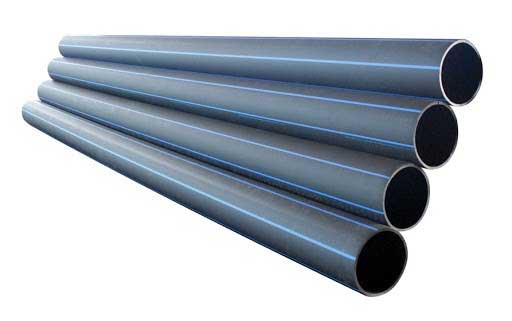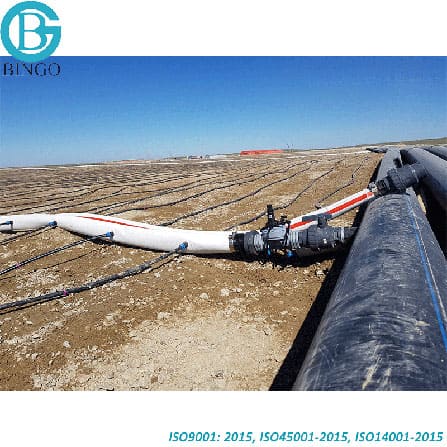FAQs About Texas hdpe pipe manufacturer and Their Process
Wiki Article
Check Out the Production Refine Behind High-Quality HDPE Pipeline and Its Applications
The production process of high-quality HDPE pipes is intricate and systematic. It starts with the choice of basic materials that improve efficiency. Following this, ethylene goes through polymerization to form resin, which is after that shaped through extrusion. Quality assurance is extremely important, ensuring that the final product meets rigorous requirements. The trip of HDPE pipes does not end with manufacturing. Their applications throughout numerous sectors disclose a more comprehensive relevance worth examining.Comprehending HDPE: Characteristics and Advantages

High-density polyethylene (HDPE) is a flexible thermoplastic understood for its sturdiness and resistance to numerous ecological elements. This product shows excellent tensile strength, making it appropriate for requiring applications. Its low-density structure contributes to a light-weight item, promoting ease of handling and installment. HDPE likewise showcases exceptional resistance to chemicals, which lessens destruction when revealed to severe compounds.
The product's reduced moisture absorption better boosts its long life, making it optimal for use in pipelines and tank. In addition, HDPE is immune to ultraviolet (UV) radiation, guaranteeing that items keep their stability also when revealed to sunlight. Its adaptability permits for the creation of complex forms without endangering stamina. The environmentally friendly nature of HDPE, often originated from recycled materials, adds to its allure, advertising lasting practices in manufacturing. Generally, these residential or commercial properties and advantages make HDPE a recommended selection for numerous commercial and customer applications.
Basic Material Selection for HDPE Production
The choice of resources for HDPE production is vital to verify the end product satisfies the desired specs and quality requirements. High-density polyethylene (HDPE) is mainly produced from polymerized ethylene, derived from nonrenewable fuel sources such as all-natural gas or crude oil. The top quality of these feedstocks greatly influences the mechanical and thermal buildings of the last HDPE.Ingredients additionally play a substantial duty in enhancing HDPE's efficiency, including antioxidants, UV stabilizers, and colorants, which boost sturdiness and resistance to environmental variables. The option procedure should think about not just the chemical composition of the raw materials yet also their handling features to ensure effective production.
The sourcing of raw materials need to focus on sustainability and conformity with environmental policies, as liable practices are vital in today's market. Inevitably, mindful basic material choice lays the foundation for generating high-quality HDPE pipes appropriate for diverse applications.
The Extrusion Process: Shaping HDPE Pipe
The extrusion process plays an important role in forming HDPE pipes, beginning with precise product preparation strategies that guarantee excellent flow and consistency. Equally crucial is the design of the die, which directly influences the final measurements and surface area quality of the pipeline. Together, these variables contribute significantly to the effectiveness and top quality of HDPE pipeline manufacturing.Product Preparation Strategies
Effective production of HDPE pipelines starts with thorough material prep work techniques, particularly the extrusion procedure. During this stage, high-density polyethylene material is first dried out to eliminate moisture, making certain optimal circulation qualities. The resin is after that fed into the extruder, where it goes through home heating and melting, changing into a viscous state. This home heating process is meticulously managed to preserve the product's honesty and efficiency. The liquified HDPE is forced with a die, forming it into a continual pipeline kind. Appropriate temperature management throughout extrusion is vital, as it straight impacts the product's homes and the last product top quality. Once formed, the HDPE pipeline is cooled and reduced to defined lengths, prepared for subsequent handling and applications.Die Layout Importance
Precision in die style plays a vital role in the extrusion procedure of HDPE pipes. The die offers as the last shaping tool, directly affecting the pipe's measurements, wall surface density, and surface coating. A properly designed die guarantees uniform product flow, reducing flaws such as abnormalities and weak areas. The geometry of the die must be optimized to fit the specific homes of HDPE, including its thickness and thermal habits throughout extrusion. Furthermore, the cooling price of the material as it goes through the die can significantly impact the pipe's architectural stability. Consequently, buying sophisticated die innovation is essential for manufacturers aiming to create top quality HDPE pipelines that fulfill market criteria and client assumptions.Top Quality Control Actions in HDPE Production
Numerous elements influence the top quality of HDPE pipe manufacturing, efficient quality control measures are critical to assure consistency and reliability in the final item (Pipe Supplier American Plastics Midland). Key high quality control techniques consist of extensive product examination, confirming that the raw polyethylene fulfills established requirements for pureness and density. During the extrusion process, specifications such as temperature, stress, and cooling time are carefully kept track of to maintain dimensional accuracy and structural integrityOn top of that, post-production testing is important; suppliers frequently perform hydrostatic tests to analyze the pipeline's toughness and resistance to pressure. Visual inspections for surface area flaws even more improve quality control. Certification from pertinent requirements companies, like ASTM or ISO, gives an added layer of reliability. By applying these comprehensive quality assurance steps, manufacturers can decrease defects, enhance efficiency, and make certain that the HDPE pipes fulfill the certain requirements of numerous applications, inevitably bring about client contentment and count on in the product.
Applications of HDPE Pipe Throughout Industries
HDPE pipes are utilized across different fields due to their resilience and adaptability. In water circulation systems, they ensure running gas line effective distribution, while in wastewater monitoring, they supply trustworthy remedies for waste transport. Additionally, agricultural watering networks gain from HDPE's resistance to rust and versatility, making it an excellent option for modern-day farming practices.
Water Distribution Solutions
A substantial variety of sectors depend on high-density polyethylene (HDPE) pipelines for reliable water distribution systems. Understood for their durability and resistance to deterioration, HDPE pipelines are extensively utilized in municipal water networks, agricultural irrigation, and commercial applications. Their light-weight nature helps with easy handling and setup, decreasing labor prices and time. Furthermore, HDPE pipelines can suit various stress degrees, making them ideal for both low and high-pressure systems. hdpe pipe suppliers Midland TX. The flexibility of the product allows for smooth combination right into existing infrastructure, decreasing the requirement for extensive excavation. In addition, HDPE's resistance to chemical leaching warranties that the water provided remains safe and tidy, making it a perfect choice for keeping the quality of potable water across numerous industriesWastewater Management Solutions
Efficient water distribution systems likewise lead the way for cutting-edge wastewater management remedies, where high-density polyethylene (HDPE) pipelines play a substantial function. Popular for their durability and resistance to rust, HDPE pipelines are excellent for carrying wastewater in numerous settings. Their flexibility permits for very easy installation in complex settings, decreasing the demand for extensive excavation. In addition, HDPE's smooth indoor surface minimizes friction, enhancing circulation prices and performance. These pipelines are also resistant to chemical leaching, making certain that pollutants do not compromise the surrounding setting. Industries, towns, and therapy centers significantly rely upon HDPE pipelines for their integrity and durability, making them a favored choice for modern-day wastewater monitoring systems. This flexibility underscores the important importance of HDPE pipes throughout countless applications.Agricultural Irrigation Networks
Agricultural watering networks benefit significantly from the use of high-density polyethylene (HDPE) pipelines, which offer efficient and dependable water distribution to plants. HDPE pipelines are lightweight, making them easy to deliver and set up, while their versatility permits various arrangements in varied surfaces. These pipelines demonstrate exceptional resistance to rust, chemicals, and UV radiation, guaranteeing longevity in extreme agricultural atmospheres. In addition, their smooth indoor surface decreases friction loss, enhancing water flow and reducing power expenses linked with pumping. The durability of HDPE pipes, often surpassing half a century, adds to reduce maintenance and replacement expenses. Farmers increasingly count on HDPE pipes to enhance watering performance and promote sustainable farming practices, inevitably leading to enhanced crop yields and source conservation.
Future Trends in HDPE Pipeline Modern Technology
As the demand for lasting and effective infrastructure grows, advancements in HDPE pipeline innovation are poised to change various industries. Arising trends include the integration of clever technologies, such as sensors and IoT capacities, which promote real-time monitoring of pipeline conditions, decreasing upkeep prices and preventing leaks. In addition, the growth of innovative manufacturing strategies, such as 3D printing, is making it possible for the manufacturing of complicated, customized pipe designs that cater to details job needs.The focus on recycling and circular economy methods is driving the technology of HDPE pipelines made from recycled materials, boosting sustainability. Improved jointing methods, such as electro-fusion and mechanical installations, are likewise boosting installment efficiency and reliability. Lastly, the expanding focus on environmental policies is pushing makers to take on greener production procedures, ensuring that HDPE pipes not just satisfy sector requirements yet additionally foster an even more sustainable future for infrastructure development.
Often Asked Concerns
How Does HDPE Compare to Various Other Plastic Materials?
HDPE outshines several various other plastic products regarding resilience, chemical resistance, and versatility. Its low thickness and high tensile toughness make it ideal for various applications, frequently surpassing options in both performance and longevity.What Are the Ecological Influences of HDPE Manufacturing?
The ecological impacts of HDPE manufacturing include greenhouse gas exhausts, energy consumption, and possible air pollution from making processes. Additionally, incorrect disposal can bring about dirt and water contamination, elevating worries concerning long-term environmental impacts.Can HDPE Water Lines Be Recycled?
Yes, HDPE pipelines can be recycled. Many centers approve made use of HDPE for processing, transforming it into new products. This reusing adds to sustainability initiatives, decreasing plastic waste while saving sources and power in the manufacturing cycle.What Is the Lifespan of HDPE Piping?

Exactly How Do Temperature Variants Impact HDPE Pipe Performance?
Temperature variations greatly affect HDPE pipeline efficiency, affecting adaptability and toughness. High temperature levels can bring about softening, while reduced temperatures might cause brittleness, inevitably affecting the pipe's resilience and viability for numerous applications in varied environments.Report this wiki page